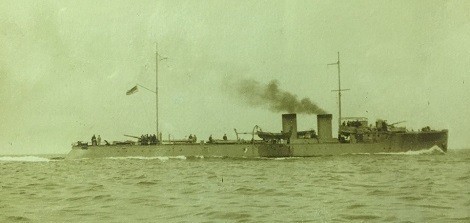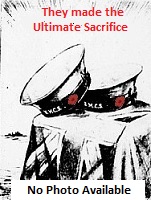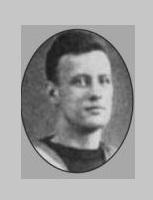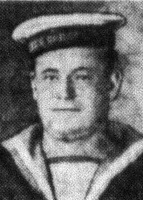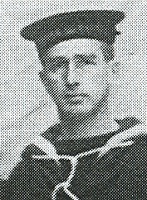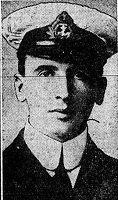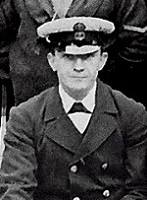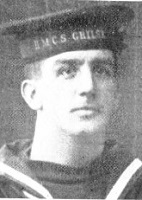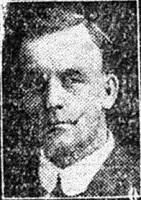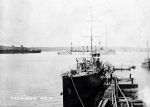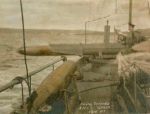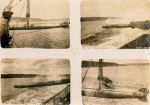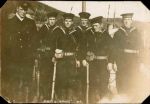|
HMCS GRILSE
Armed Yacht
HMCS GRILSE HMCS GRILSE, seen here steaming at high speed From the collection of Richard Pearson / Courtesy of Jeffrey Read Click on the above photo to view a larger image
Built by Yarrow & Co., Glasgow, Scotland, HMCS GRILSE was the Royal Canadian Navy's closest ship to a destroyer during the First World War. In Jun 1915, millionaire Jack Ross purchased the Winchester, one of the fastest civilian yachts in existence, from the United States and brought it to Canada. Commissioned as HMCS GRILSE in Jul 1915, and with Ross in command, the ship was refitted and armed at the Canadian Vickers shipyard in Montreal before sailing to Halifax to start carrying out patrols. Easily the fastest ship in the Royal Canadian Navy (RCN), GRILSE could reach speeds of more than 30 knots (55 km/h). Since she was unsuited for winter service in Canadian waters, GRILSE left Halifax on 11 Dec 1916, for the Caribbean and was reported lost in a storm. She turned up at Shelburne, N.S. three days later, however, having lost 6 men who were washed overboard during the storm. After several months' refit GRILSE resumed her patrol duties until she was paid off on 10 Dec 1918. An effort was made to sell her in 1920, but no adequate bid was received, and during 1921-22 she was attached to a youth training establishment in Halifax dockyard. In 1922 she was sold to Solomon Guggenheim, who renamed her Trillora, and was still in his possession when, on 21 Sep 1938, she foundered at her jetty, in a hurricane at Roslyn, Long Island Sound.
Photos and Documents Ship's company photos
Commanding Officers
They shall not be forgotten
Photos and Documents
(GRL001) HMCS GRILSE - undated (GRL002) HMCS GRILSE in Bedford Basin 1916 // In this 1916 photograph, HMCS GRILSE is tied up at a dock in Halifax harbour. Halifax remained Canada's busiest harbour during the First World War, filled with civilian vessels (left) and warships (right) like those seen in the background. Shipments of war supplies, food, and soldiers arrived and left nearly daily. GRILSE was among the Canadian naval vessels involved in protecting ships along Canada's coast against U-Boat attacks. In the fall of 1916, however, GRILSE's high fuel consumption restricted its activities to special patrols to protect important ships. // Source: George Metcalf Archival Collection CWM 19940001-943 // Courtesy of the Canadian War Museum (GRL003) Article on HMCS GRILSE, believed to have foundered in a storm // Dec 1916 // Source: Facebook post of Barry Archer (GRL004) HMCS GRILSE - date unknown (GRL005) HMCS GRILSE firing a torpedo // This rare colourized photograph captures the launch of a torpedo from HMCS GRILSE, a civilian yacht converted to a quick torpedo boat for patrol and escort duties. The torpedo tube seen here (centre) and two 12-pounder guns were the ship's main armament. Like the guns, the torpedo tube could be rotated to aim the weapon at enemy ships. A spare torpedo for reloading the tube can be seen in the foreground. By the time of this photograph, newer, larger and more powerful torpedoes were in widespread service, but GRILSE's 14-inch models could still inflict significant damage. // Source: George Metcalf Archival Collection CWM 19940001-948_1 // Courtesy of the Canadian War Museum
(GRL006) Torpedo Practice, HMCS GRILSE // These photographs show HMCS GRILSE taking part in a torpedo firing exercise, a type of practice important for maintaining the ship's fighting efficiency. The photographs at top right and bottom left show one of GRILSE's torpedoes being fired. Torpedoes were expensive and complicated weapons, and every effort was made to recover them after test firing. "Practice heads" made the torpedoes float at the end of their runs so that they could be recovered easily by small boats like the one seen at bottom right. // Source: George Metcalf Archival Collection CWM 19940001-947 // Courtesy of the Canadian War Museum (GRL007) Two crew members of HMCS GRILSE // Sailor Isaac Ernest Brown (right) and an unidentified comrade pose on the open bridge of HMCS GRILSE. Brown, on the right, rests his hand on the ship's wheel. The other sailor rests his right hand on the bridge telegraph, which sent a signal to the engine room to reduce or increase speed, or to reverse the engines. GRILSE, built as a civilian yacht, retained its open bridge after conversion to a torpedo boat. Without protection, the bridge could be a wet and miserable place when GRILSE ventured out to sea. // Source: George Metcalf Archival Collection CWM (GRL008) Sailors of HMCS GRILSE // Jack Ross (left), seen here with armed members of HMCS GRILSE's crew including one carrying a cutlass (right), purchased the GRILSE for Canadian naval service. Deemed medically unfit for overseas army service, Ross, one of the wealthiest men in Canada, sought a place in the navy by obtaining fast American yachts for the Canadian government. After purchasing the first vessel, which became HMCS Tuna, he was appointed a naval lieutenant. In 1915, Ross acquired another yacht, which became GRILSE, a ship he would command from October 1915 to July 1916. // Source: George Metcalf Archival Collection CWM 19940001-945 // Courtesy of the Canadian War Museum 19820331-005 // Courtesy of the Canadian War Museum
|

